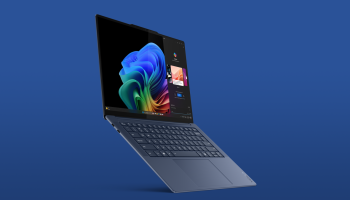
[ad_1]
When you think of a television show that’s emblematic of the ‘90s, none are more quintessential than Beverly Hills, 90210. From the cheesy, guitar-heavy intro music to the too-high-to-heaven hairstyles, the show became an international hit by depicting a group of attractive teens growing up privileged in Southern California. From 1990 to 2000, it served as a forever time capsule of the decade that made consumer technology a staple in everyday life.
Anyone who knows me, personally, knows my unhealthy obsession with this show. I didn’t tune in when it originally aired, except for the few episodes I managed to sneak-watch in the later seasons. As the show concluded on Fox and I entered my early teens, I began watching the reruns on FX and, later, SOAPNet. That’s when I realized the show could serve as an escape for me; I imagined myself running away to Los Angeles to chase the sun. I wanted the freedom these rich kids had.
I also wanted the crap they had floating around in the background. Not only did I like their clothes and want to see the bands that they saw live at the Peach Pit After Dark (The Flaming Lips! Christina Aguilera!), but I also wanted access to the internet as they had in season five when the epic storyline of Kelly getting burned in a housefire starts up by way of an errantly-posted rave flyer on a message board. These were all little moments that kicked off more significant plotlines in the show, and they were a great example of how computers and the internet became background characters to the decade.
I’ve watched all ten seasons of the show every year since 2005. During the height of the covid pandemic, I started watching it daily—they say that we’re more likely to default to our comforts in times of duress. That’s why I’m the perfect person to serve as a tour guide through tech and the internet, as depicted on Beverly Hills, 90210, throughout the 1990s.
G/O Media may get a commission

$32 off
The Hair Revitalizing Complex Full Set
Fight hair loss with science
Right now, you can get The Hair Revitalizing Complex Full Set for the price of the Refill. That’s just $98 for a 30-day supply, and $32 off the supplement’s normal price. This supplement is proven to deliver results. Augustinus Bader performed a six-month double blind trial that found those on the supplement had increased their hair count by 56%, hair shine by 100%, and saw a 98% reduction in hair damage compared to those who took a placebo.
The privileged tech of the 90210
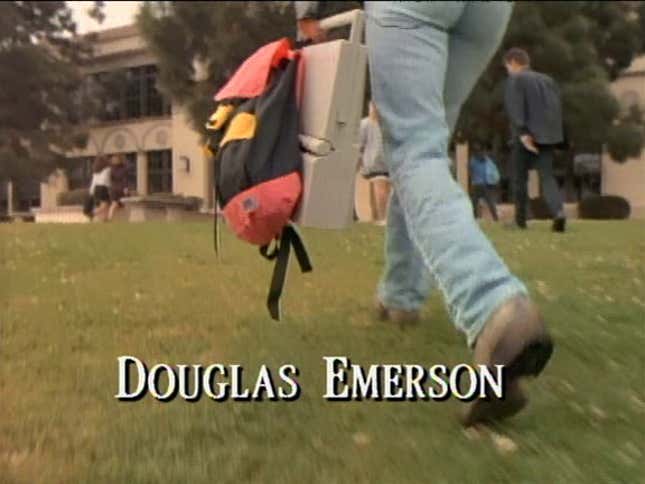
Beverly Hills, 90210 wasn’t symbolic of many teenagers’ experience in the ‘90s—the kind of money and access these kids had was not the norm. West Beverly Hills High School was modeled after the real-life Beverly Hills High School, which boasts wealthy and privileged real-life alums such as Lenny Kravitz, Angelina Jolie, and even the Kardashians. While these rich kids were ostensibly teaching viewers about classism, racism, microaggressions, and how to have safe sex, they were also driving expensive sports cars and wearing clothing brands that only a banker or a lawyer’s kid could afford at the time.
Technology became the background character in the show starting in season one. In the pilot episode, we see b-roll of a supposed student at West Beverly carting around expensive laptops like the Macintosh Portable. That chunky laptop came in at around $7,000 in 1990 with a hard drive in tow, more than the cost of my last three computers in the new millennium.

The kids had access to a class called “Tech Shop”—I’m still puzzled about what technology they were tinkering with, as the show depicts beakers and random circuitry instead of the desktop computers I remember from the elementary school computer lab. Tech Shop became somewhat of a tertiary character in season one. It’s where Brandon and the viewers meet Dylan McKay, played by Luke Perry, who became the show’s resident bad boy. It’s also where Brandon does his first of many sanctimonious takes in episode 5, where he accuses a black student-athlete of receiving preferential treatment. (The storyline was cringe, and Brandon apologized to the student afterward, but the drama started there in that tech room.)
By 1991-1992, the show had grown in popularity enough that the network took a gamble on airing a “summer” season wherein the kids and teens at home could watch in real-time as the gang enjoyed their break from school. Tech Shop was no longer part of the curriculum, but there would be moments of dialogue and transitionary scenes showing that technology had space at West Beverly High.
David Silver, played by Brian Austin Green (or “BAG,” as the fans call him), was introduced to us as a nerdy wannabe with hobbies like making music with his electric keyboard. Naturally, he morphed into one of the more tech-savvy members of the cast—many of my favorite tech-centric lines come from his character, and it’s clear that he was written as a gadget head from the very beginning. In episode four of season two, David geeks out over a rear-projection TV present in the gaming room when the gang sneaks into the Beverly Hills Beach Club after hours to play poker. In one offhanded comment to Steve Sanders, played by Ian Ziering, he schools viewers on why rear projection was considered a better technology at the time through one punchily-delivered line. Simply, it had “twice the brightness.”

Large TV screens became more readily available to consumers starting in 1991. According to this vintage article from the Los Angeles Times, which was published around the same time this episode debuted, sales of TV screens larger than 27-inches had increased 13% that summer—there’s no doubt that the Beverly Hills Beach Club had budgeted some of its cash that summer to upgrade the TVs in the game room. Rear-projection TVs, which were as big as 53 inches, were labeled as having “gained ‘yuppie toy’ status,” which fits the mold for Beverly Hills, 90210.
Season two is also where we learned that The West Beverly Blaze, the school newspaper, was edited and produced on desktop computers. In episode 12, Andrea Zuckerman, played by Gabrielle Carteris, also editor-in-chief of the Blaze, pens a letter of resignation on what appears to be a computer running MS-DOS (my brother-in-law thinks it’s this one specifically, but we’re going off a screencap). Andrea convinces herself the ruse that she’s living at her grandmother’s apartment in Beverly Hills won’t fly with the school board and that she’ll have to go back to school in the valley. Later in the episode, she impassionately reminds her friends during lunch that she was going through all the trouble to lie because West Beverly High offered access to technology and programs she didn’t have in Van Nuys. “You people have no idea how good you have it…You think every place is like this.”
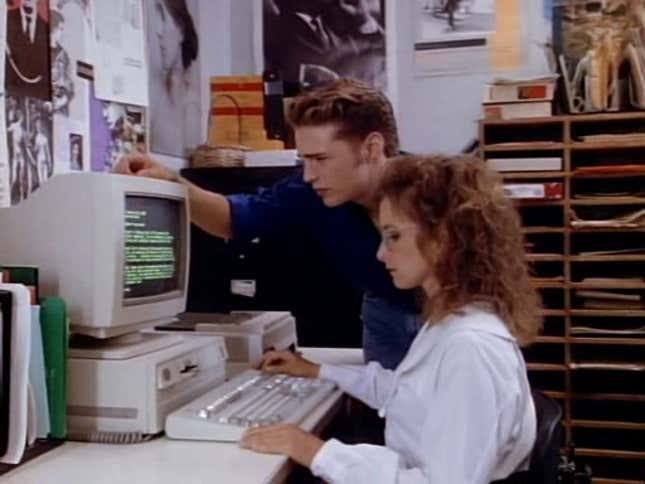
Indeed, computers were becoming more commonplace in public schools in the United States. By 1991, about 98% of schools were using a computer for instruction, up from about 18% in the early ‘80s. Computers were also more readily available, with one computer for every 18 students, making it easier to access for curious tinkerers.
The most famous tech-tinged storyline in the entire series—and the one that taught me about the concept of “social engineering”—occurs in season three. It’s one of my favorite multi-episode arcs. Steve Sanders, who I mentioned earlier, is the resident jock and “cool guy” on campus. Although he’s boorish and often offensive, he has the best outcome of all the characters by season ten. Each season they had him navigating some troubling situation. In season two, it was steroids on the school track team. And in season three, it was hacking into the school to change his grades.
Steve Sanders is not the hacker in this situation. The storyline starts in episode 8 when a recently-graduated West Beverly High alum seeds Steve with the so-called “legacy key.” This key is supposedly a master key that unlocks every door in the school, including the room where they store the grades. Steve, fearing that he won’t make it into the University of Southern California with his dumpy scores, decides to try to break into the school to change his transcripts. To his chagrin, the grades are not just letters written down on paper. After all, it’s the ‘90s, and because this is an affluent school, all that information has been digitized and stored on a computer.

Instead of working his ass off to make the grades, Steve decides to employ a tech-inclined scapegoat to help him. This is when we meet Herbert Little, Steve’s freshman buddy, who also happens to be a computer hacker in his spare time. However, for Herbert to access the school’s computers, he needs the master password. Steve, ever the master bullshitter, makes the call pretending to be from the “Computer Network Maintenance Corporation.” He successfully phishes the password from the school district’s IT department. It’s almost too easy—and way easier than 2600 told me it would be.
In the end, Steve and Herbert’s efforts to hack into the school’s mainframe don’t quite work out. The police catch on that there was a break-in and launch an investigation. Eventually, Steve fesses up to the attempt to change his grades and spends the rest of the school year in before- and after-school detention, where plenty of other plotlines occur throughout the season.
When consumer tech graduated
By season four, the gang had all graduated from high school and entered college. All eight of them end up at the big (and apparently prestigious?) university called California University—in reality, they were filming on location at Occidental College in Eagle Rock. Their campus was chockfull of mid-’90s technology gems.
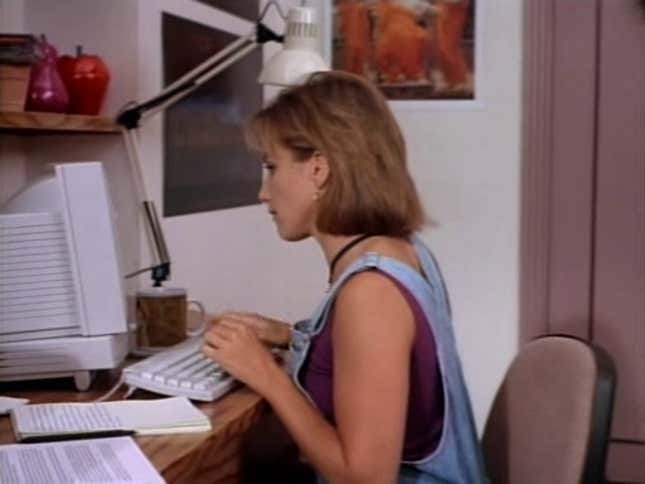
Thanks to a scholarship, Andrea has a Macintosh and a laser printer in her dorm room. And everyone from Kelly Taylor, played by Jennie Garth, to Donna Martin, played by Tori Spelling, has either a car phone or a cellphone on them—Donna had hers embedded in her BMW’s middle console, which was a standard option available at the time.
There are some non-computer tech moments that come up in the college years that remind us how far we’ve come with other types of consumer technology. Remember tapes? Well, they used to melt, especially if you stored them in the glove compartment of a hot car, as Donna discovers in episode three of season four.

Season five takes place between ‘94 and ‘95, and it is chock full of technology tidbits—not to mention melodrama. I was struck by how often I was running into hot tech at the time, just sitting pretty in the backdrop of these rich people’s homes and dorm rooms. Even Donna’s mom gets herself an Apple PowerBook, relaunched later that year with a faster processor and color screen. But at a starting price of $1,600 a unit, it was only within reach for the affluent. (The Apple Tax hasn’t let up since then.)
Season five also brings on Clare Arnold full-time from the previous season, played by Kathleen Robertson. Clare is the daughter of the school’s chancellor, and she becomes one of the show’s resident techies throughout her four-season tenure. She dates David for one season, and while together, they’re pegged as what we would now call “extremely online” for the time. They both know their way around computers and video equipment, and they’re both taking “Intro to Media.” David first encounters her at the school’s computer lab in episode four, where Clare is making graphics on what appears to be a Macintosh LC desktop computer for a video assignment. “That’s some program. Did you write it?” David asks her. “No, I had to shell out 30 bucks like everybody else,” Clare answers. Good for her for not pirating it.
These two are also how we get into season five’s fiery storyline. It all starts in episode 13 with a post on a bulletin board. David and Clare are surfing on the Delphi Forums for a place to drop an advertisement for a rave that Steve is hosting in an abandoned mansion. When the episode debuted in November 1994, it had been about a year since Rupert Murdoch purchased the Delphi site in hopes of investing in a burgeoning part of the internet (big MySpace energy). Unfortunately, that sale spelled the beginning of the end for Delphi’s reign, as several subsequent shoddy business moves hurt it enough that the forums were struggling to stay open by 1996.
Kelly is the one who also gets hurt in that house fire. But it’s hard to focus on the seriousness of that without first getting through the silliness of how the story arc starts: David accidentally drops the digital flyer for the rave in a channel for “women-seeking-women.” (It seems hilarious until you realize that later in the episode, lesbians become the punchline.) As Steve notices that only women couples are showing up for the party, he asks David, “When you posted this online, where exactly did you post it?”
“The, uh, college party line,” David answers. “Of course, at first, I did drop it in the wrong forum,” he admits.
“Oh well,” Clare remarks, helping diffuse the situation. “The more, the merrier!”

At its core, the one forum post is a minor plot device. But it ends up erupting into massive character growth for Kelly. Kelly and Allison, who is half of the first lesbian couple we see arriving at the party, end up trapped in the fire together. They’re the last ones rescued as the credits start rolling at the end of the episode. Kelly makes it out of the fire with minimal damage to her model-worthy face, while Allison ends up so badly burned she needs skin grafts. This all ends up leading to Kelly joining a cult. It’s a long story. But how many forum posts have circuitously led to people joining a cult? I’d wager a lot.
Season six starts to get a little whacky. Charles Rosin, one of the original writers of the first five seasons, starts his exit around this time. His absence is palpable as the season progresses. The episode becomes less about the gang’s bond and more about dramatic storylines to compete with its spinoff, Melrose Place. But technology remained a part of the antics.
One of my favorite moments of season six involved Clare and Steve. Clare and David have broken up by now, and she’s moved on to tutoring Steve in remedial math. In episode four, we learn that Steve gets her attention by pretending to be a sensitive guy in a chat room. However, she doesn’t realize it’s him until they both ditch each other for their respective online dates, only to discover they are actually both talking online—Steve is known as “Tender Heart” in the chat, while Clare goes by the alias of “Cuddles279.” This kicks off what turns out to be a beautiful relationship between the two and the beginning of Steve’s series-long redemption arc.
While I’m not entirely sure of the chat application they were getting their “cyber sex” on—it’s referred to as such by Brandon, gag—this was filmed in 1995 when the first online dating sites started cropping up. Based on a screencap, which lists the application as “People Connection – CU,” I’m assuming the interface is a spoof of Stanford’s inter-campus Web Personals.
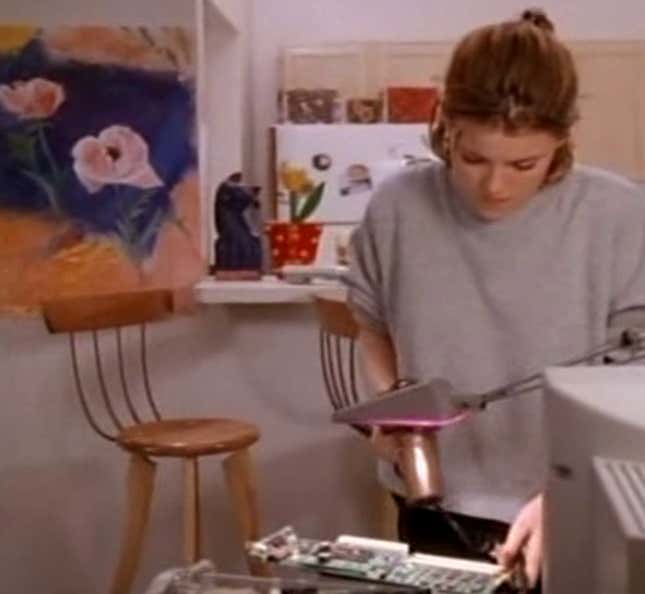
The computer play between Clare and Steve doesn’t stop there. In season 7, we see Steve’s true potential as a “tender heart,” helping lend credence to the username he was floating around with online. In episode 25, Clare freaks out after she knocks a cup of coffee all over her computer, causing it to short. There’s smoke coming out of the machine, and later, she attempts to dry out the motherboard with a hairdryer (I’ve done this before). Although she blames Steve for the accident—she spills the coffee while he’s on the phone attempting to convince her to delay her work—he eventually comes to the rescue with a good old “disk utilities program.” Clare realizes he wasn’t at fault for the mishap and sends him flowers as a truce. It’s one of the last peaceful moments we see between them before Clare exits the show by moving to France with her father.
When it all went to shit
Beverly Hills, 90210 is difficult to watch in the later seasons. Many of the original writers of the show had left by season eight. And season nine saw the departures of Jason Priestley and Tiffany Amber Thiessen, who played Valerie Malone (unfortunately, she was given little to no tech-centric storylines, though the writers had no problem slut-shaming her through her run). This is where I get less nostalgic and have the least affinity for the show. Spend a few minutes on the fan-run subreddit or my favorite meme account, 90210Stupid, and you’ll see plenty of folks who agree with me.
There are still a few worthy tech-centric plot drivers in the later seasons. But they were fewer and far between because, at this point, consumer technology was no longer something we were gawking at; it was an embedded part of the late ‘90s lifestyle. We had access to more affordable computers and devices, and we had the internet. About 40% of American households were online when the last season aired. In some ways, the last few seasons are a marker of how the connected world we’re living in right now came to be.
In season eight, Brandon and Steve start a rag called the Beverly Beat. It morphs into a National Enquirer-style publication by the series’ end. It begins as Brandon’s valiant effort to get into journalism without actually working up the ranks like the rest of us. They hire Janet, played by Lindsay Price, to help manage the paper. Brandon files his stories for the Beverly Beat on what looks like the Apple PowerBook 3400c, which came out in February 1997, when this season would have been filmed. The scenes in the “newsroom” are fun because we get glimpses of the consumer tech that was floating around professional spaces at the time.

Before Brandon leaves in season nine, Janet pitches Steve on the importance of maintaining a website for the Beverly Beat. “People will be able to access articles online,” she explains. “We’ll expand our reader base. We’ll get more subscribers and advertisers.” She makes it sound so easy. After her pitch, a character named Sophie latches on to the idea of hooking up a webcam to capture the “hustle and bustle” of the newsroom. Naturally, Steve likes it because he thrives on chaos.

The camera they use is none other than one of the first webcams, the Connectix QuickCam. Sophie and David get frisky in the newsroom after hours, and since they’re still live streaming, the internet gets a free naughty movie, one picture at a time. Things like this totally happened in the heydays of internet-connected webcams. I remember accidentally leaving on my webcam while picking my nose at the computer. Thankfully, no one but me was looking at my website back then.
The rest of seasons nine and ten are a slog to get through. Dylan returns after Brandon leaves, and the writers start reworking old storylines from the show’s initial run to appeal to longtime viewers. I was surprised to see that by season nine, he’s a storied computer user, complete with his own Apple PowerBook G3. When I last saw him in season six, he could barely type a message to the FBI on a typewriter. But here he is with a Mac in 1999. Just like the rest of the world that decade, Dylan had to adapt as quickly as possible, as this was how he would be navigating the new millennium.

I’m bummed that the writers didn’t think to do a Y2K-themed episode, but it was clear by season ten that all Fox wanted to do was kill off the show and bring in something new. The world had moved on. Young people were no longer like the cast, the cast was no longer young. And the high school experience would never be the same.
[ad_2]
Source link





